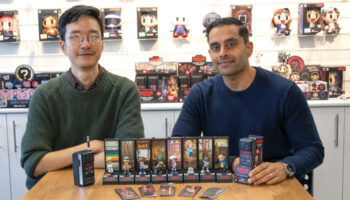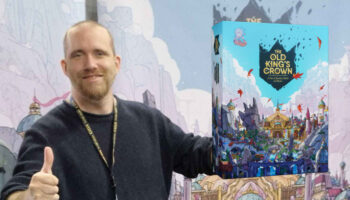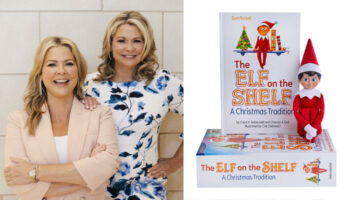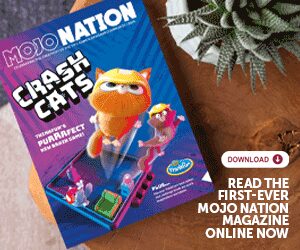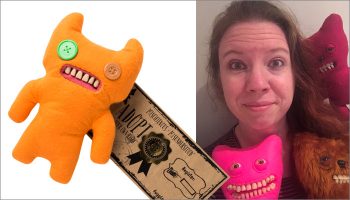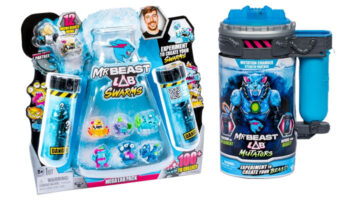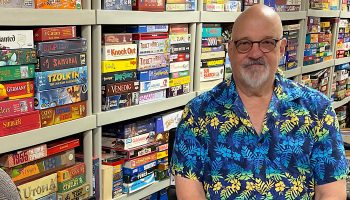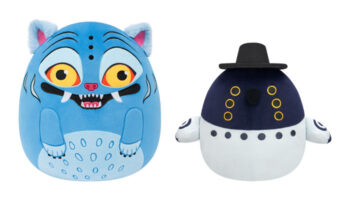What makes Folkmanis Puppets great? Art director Allison Sieber on why the company’s in great hands

Allison Sieber, I’m so thrilled you’re here! Am I pronouncing your surname correctly? See-ber?
Exactly right. It’s German; I’m told it means ‘maker of sieves’.
Maker of sieves? Wow… Did that used to come up a lot in Germany, then? They made a lot of sieves?
Ha! I think it’s archaic, like a chandler.
Well, either way, I’m thrilled you’re here. We’ve not really done anything on puppets before, but I just LOVE your stuff. What’s your role at Folkmanis?
That’s a harder question to answer than you might think! We’re a very small family company… I got brought on to take over from a really fantastic person who retired. She started out in Industrial Light and Magic working on movie sets! She did a bunch of the Pirates of the Caribbean sets, for example… So she had a great artistic-production background and a lot of tech knowledge. And what she did that I’m doing now is putting together and maintaining a lot of the visual aspects. That said, I usually just tell people I’m an art director because that’s probably the best short description.
It sounds like you would have had a hand, then, in the beautiful booth we saw at the toy fair in New York?
Thank you! Yes, for New York Toy Fair, I was making sure the visuals were right for the set we put together. You know, Folkmanis has done that booth for over 30 years in pretty much the same way. It’s intentionally very old fashioned… We do it specifically like that so it stands out, since not many people do that very old-school look and feel.
Perfect, thank you! And we’re going to have to include plenty of images in this piece because one thing I want to make clear is that your puppets are AMAZING!
Oh! Thank you! Well, images and digital assets are my wheelhouse, so we should have no trouble getting hold of photos!
Ha! Perfect! So… Your of range puppets is literally an A to Z of animals and fantasy creatures: alligators to zebras and beyond! Which puppets should we talk about today to illustrate your range?
One interesting thing about our puppets is that we fill a very specific niche. I think that’s one of the reasons that we’ve been around for nearly 50 years – it’ll be 50 years in 2026. One of the reasons for that is that when Judy Folkmanis started the company, she somewhat inadvertently created a new type of puppet! Her puppets were realistic animals but made in very detailed soft plush and designed to be puppeted in your arms as you interact with someone else, or walk around. Up to that point, most puppets were either more cartoony fabric puppets – like the Muppets – or they were realistic but made out of hard materials, like a marionette or Punch and Judy puppets.

On top of that, most puppets were designed to be used in a puppet theater, not out interacting with people. They often didn’t even have lower bodies or feet… But Judy was making complete, realistic animals in flexible, movable fabric. That means anyone can easily use small hand-and-wrist movements to get a ton of emotion and movement out of their heads and faces. And puppeteers with a very flexible wrist style of puppeteering can get some really amazing movement out of them!
A flexible wrist style? You’re miming it there for me… How does that help?
If you have a puppeteer with a flexible wrist, you can get a much greater range of reactions and expressions out of a soft fabric puppet. Picture the way Kermit the Frog’s whole face scrunches up! Muppets were designed to be incredibly soft and flexible and do just that, but they still used the TV screen like a puppet stage, to crop off the bottom of the puppet, so the puppeteer doesn’t interact with their puppet.
Got it. So there’d been old-school puppets and there’d been Muppets…
Right. Then, when Judy Folkmanis started making and selling her puppets in Berkeley, they were just like this little raccoon I’m holding: all flexible fabric, but in a more traditional glove-puppet style. Judy would walk around on Telegraph Street holding these guys and playing around with them like a real animal… As I do it, you can see that we get a lot of micro movements out of him.
It’s amazing! You’re making it twitch its tail and face… To the point that I would say – even from a small distance – that people seeing Judy do that on the street would simply think: that woman’s got a raccoon!
That’s exactly it. Once you get a little movement in there, they can really come to life. But when you see these guys just sitting on the shelf… What is that?! It looks like a plush that’s under-stuffed! You don’t get what these puppets are until you see someone puppeteering them. And I’m not a professional puppeteer, of course – some of my coworkers are – but anyone can get so much movement out of our puppets, just picking them up for the first time.
Amazing! They just look incredible, even this close up.
Funny you should say that – we call this close-up puppetry, kind of like close-up magic – like when someone’s doing card tricks at a restaurant table. This is exactly what Judy Folkmanis used to do at her little store booth on Telegraph Street, near the Berkeley Campus. People would come over to get a closer look – and she would sell them the puppet.

This is a great origin story!
There’s a fantastic picture on our website of Judy, in her 1970’s pigtails, with some of the puppets on her original stand. So Judy did the creative side of things and her husband Atis eventually left his job as a biochemistry researcher at Berkeley to help her run the business. Anyway, in that photo, some of the puppets are still very cartoonish big eyes and big mouths!
Over time, though, she started making the puppets more and more realistic; more and more detailed – which is one of the things we’re still known for now. As to what else we have in our range, we also tend to make incredibly sculptural puppets. This is one of our newer puppets – it’s a Sphinx cat. The designer who made this loves creating fun and unusual animals… People either love them or hate them! Either way, the detail is incredible – look at that face!
Those eyes are incredible. Are they made of plastic or glass?
All our eyes are plastic – glass is too much of a hazard. And whenever we’ve experimented with stitched eyes, we don’t get the realism. Also, I don’t know if you can see – he’s got these little wrinkles… These are a mix of ruching, which are actual wrinkles in the fabric, and a cleverly designed print. Now, another one of our puppet designers is a birder. She loves birds… We have long discussions about how accurate we can make puppets because sometimes – if we make them too accurate – they won’t be as cute. So – for example – this bird is realistic up to a point, but it still has a really sweet, lovable face.
What kind of a bird is that, Allison? And is it my imagination, or did you make him walk?
No, you didn’t imagine it! Ha! We designed this one so that some fingers can puppet his little mouth. But he also has hollow leg bits so you can make him do a dance. That’s because he’s a blue-footed boobie. Blue-footed boobies do a mating dance that’s a lot like this little can-can I’m making him do now.

Look at it go! Ha! This is great! So… Puppets and dolls are presumed to be among the oldest kinds of toys in the world. What is it, Allison, that you think accounts for puppets’ ongoing popularity?
I think there’s definitely a crossover between puppets and dolls, and both are important for human developmental stages. You see that when kids start picking up almost any object and immediately use it to play act! The object becomes a little person; a representation of themselves. It’s so deep-rooted in us that adults do it too! It’s just part of how we communicate because we’re so visual and we’re so tactile. Of course, one of the things about puppets is that – unlike a doll – you can manipulate them so much more, which means you can communicate more… By way of example, this turtle puppet is popular with therapists…
Oh? With therapists using it as a puppet? Or giving it to the client to use?
Both. He goes in and out of his shell, and we also make a matching little baby turtle so you can represent a family unit. Even though it’s a very simple puppet, he can pull into his shell to express how shy he’s feeling, or how much he’s ready to talk. That’s incredibly useful in therapy. Similarly, a lot of times – especially with kids, but with adults too – if you say something through a puppet, you have just enough of a disconnect that you can express something you wouldn’t feel comfortable expressing otherwise.
So there’s just enough safety with this little puppet in between you and me: what I say doesn’t come from me: it comes from the puppet! And even though it’s very obvious that I’m manipulating the puppet, we can both buy into it. It’s like being part of a magic trick: it’s participatory. We’re agreeing together to pretend the puppet is real, so to us it is.
This is fantastically interesting to me! I’m curious, though: over the last 50 years, the company must’ve done an awful lot of animals, birds and mythical creatures… What’s the process of developing a new puppet?
Interestingly, I think that’s part of the tension and part of the secret sauce! You’re right: we’ve done every animal you can think of! Our current Creative Director, Elaine, has a memory like you wouldn’t believe… She’ll remember that we already made some specific animal back in the 1990s and say, “You know what? We made one of those before. I’ll show you; let me get it!” Then she’ll go through what was great about that puppet, and what was a problem! And decades later, we might have much better fabrics or fabrication processes, so we might decide to make that animal again – but differently this time…

Similarly, there might be a type of animal that didn’t go over quite as well as we hoped years ago. But something might’ve changed to make that creature more well-known or well-loved, for example. The only thing we did at one time that we’ve now moved away from, I think, is puppets on the people end of the range… Things like fairies and gnomes and princes and princesses. We’ve realized that our biggest strength is the soft plush animals, because no one else is doing them in the way that we can.
I’m very taken with this back-catalogue and rich history. What are the company’s values, Allison?
Thanks for saying so, it’s very important to our team! First, we have some employees who’ve been here 30 or 40 years… So in terms of values, it really is a family company. It’s still owned and run by the two sons of Judy and Atis Folkmanis. And a lot of people who work here are friends of the family as well as friends among themselves. We’re part of a community; we’re bonded that way and I think that shows in the product…
These puppets aren’t designed for performance on stage – although certainly people do use them for that. But we design them for hands-on, interactive puppetry between parents and kids and everyone in between. It’s all about interactive play. You can use these puppets to teach communication and fine-motor skills while still having something that feels like a lovable companion. So we’re much more Velveteen Rabbit than Tin Soldier if you know what I mean…
I do – and I think that’s a very charming analogy!
One other thing that I think is worth mentioning in relation to values: we love animals! That means we’re never going to do a circus elephant in a ruffle, for example, or a bird in a cage. We know people love their pets, but we like to think of our animals in a kind of natural state where they belong to themselves.
They’re all free spirits! I like that! Before we wrap things up, I must ask how you came to be working here! What’s your background?
I got this job partly due to pure luck and partly out of only wanting to do things that made me happy. I worked in advertising for years: I did a lot of broadcast ads for great companies, and I loved that job. I like creating and there was a great range of work… Writing a commercial one minute, being on a set with a guy who directs music videos the next. There were days when I got paid to draw and others when I ended up working with the visual-effects people just off The Dark Crystal set!

Of course, that type of work can also be a grind – so you need a creative outlet. I’ve always enjoyed creating creatures and puppets and kind of strange, disturbing drawings! I’m also part of the cosplay community and when I make a costume, I usually have some part that moves and comes alive, or I make some little puppet to walk around and startle people with.
Of course you did!
Yeah! And for a long time, I would say that my dream job would be to make puppets full-time. Well, purely by luck, one of the Folkmanis employees has a workout buddy who’s a friend and when she mentioned that they were looking for a new employee, my friend recommended me right on the spot.
Fantastic. Well, it feels like a match made in heaven! Thank you so much for making time to speak with us, I’ve loved every second of it.
–
To stay in the loop with the latest news, interviews and features from the world of toy and game design, sign up to our weekly newsletter here







